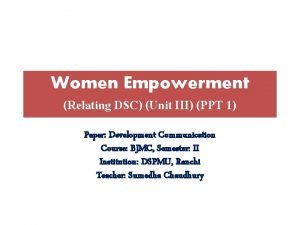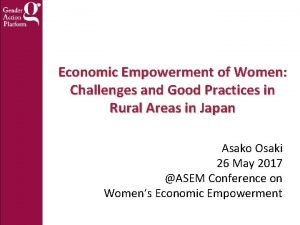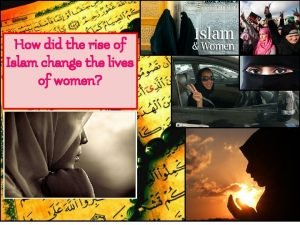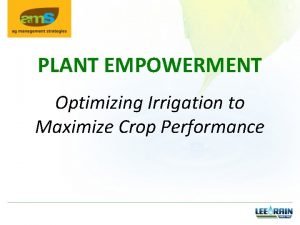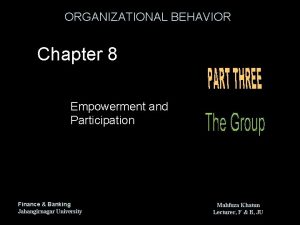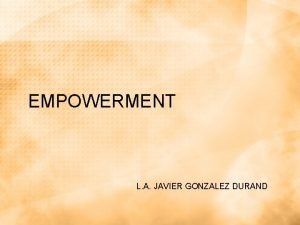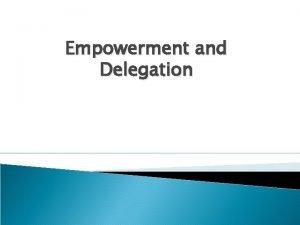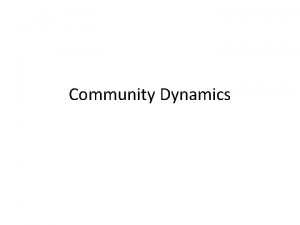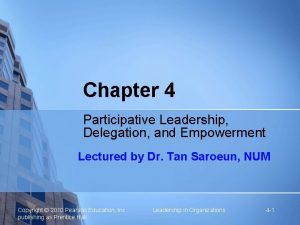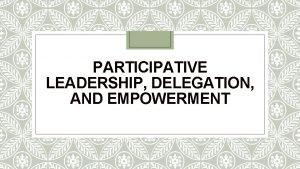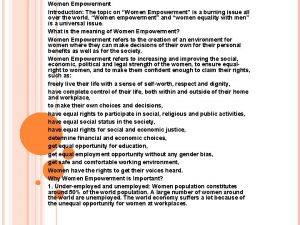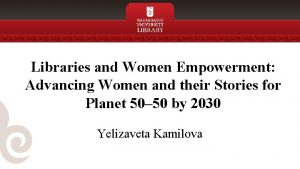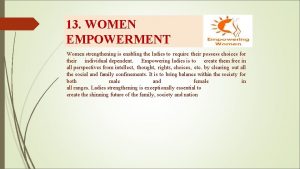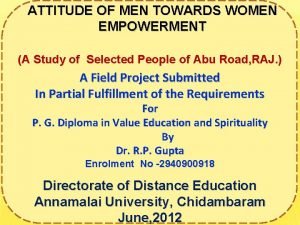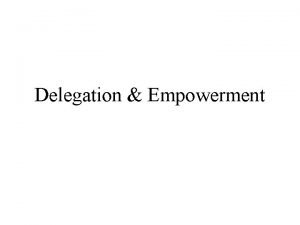Roma Women Empowerment A Change Under Construction Towards














- Slides: 14

Roma Women Empowerment: A Change Under Construction Towards a Roadmap for Advancing the Situation of Roma Women in the Council of Europe Member States Research conducted by Dr Zora Popova for the Co. E Roma and Traveller Team

Purpose • In support of the organisation of the 8 th International Roma Women’s Conference (IRWC) in 2021 (ADI-ROM Terms of Reference) • To contribute to the Co. E work dedicated to Roma women empowerment • To contribute to EC Roma integration efforts • To address issues and goals set by: • Co. E Europe Gender Equality Strategy (2018 -2023) • Co. E Strategic Action Plan for Roma and Traveller Inclusion (2020‑ 2025) • UN Strategic Development Agenda 2030 • To support Co. E member states in their efforts to advance situation of Roma and Traveller women • Framework for assessment of gender aspect of Roma integration policies at national level • Model for national Roma Women Empowerment Roadmaps

Methodology • Research question: Are Roma integration policies ensuring efficient protection of Roma women’s rights (with focus on multiple and intersectional discrimination) and are they enabling development of the full potential of stakeholders? • Term used: Roma Women – Co. E definition of Roma and Traveller developed further to indicate the lack of (reported) differences between the situation of Roma & Traveller women • Analytical framework: 2012 - European Women’s Lobby (EWL) Position Paper on Tackling Multiple Discrimination of Romani and Traveller Women 2013/2016 – European Parliament Resolution on Gender Aspects of NRIS • Comparative analysis: NRISs of BG, CZ, HU, RO, SK (Roma) & IE (Traveller) NRIS = national strategic documents under international monitoring • Sources: NRIS 2020 – latest versions (as available) Relevant strategic policy documents (for 6 states) Co. E/ADI-ROM thematic survey: replies received from AT, BA, BG, CH, CZ, DE, EE, EL, HR, HU, NO, RO, SK (Thank You!)

Selection of Cases • Roma in Europe as % of population • Gender Equality Index 2019

Analytical Framework Normative basis Policy Design Policy Elements • Safety (protection from all types of violence) • Policy planning on ethnic/gender disaggregated data • Cultural barriers (set by traditional practices and roles) • Gender impact evaluation • Awareness raising of Roma women • General anti-discrimination law covering Roma women • Gender equality as a horizontal line in • Training/awareness raising of public officials • Normative/strategic documents on Roma women • Multiple discrimination / intersectionality • Employment Roma inclusion • Education • Comprehensive measures • Healthcare • Indicators • Housing • Generation-sensitive approach • Targeted social measures • Gender mainstreaming • Participation (public/political life and decision making) • Capacity building and support to NGOs

Findings Normative basis Policy Design Policy Elements Roma women and girls are protected by anti-discrimination laws National governments have a clear understanding about the problems that Roma women face and about the multiple and intersectional discrimination that they are exposed to In all the policy areas, but housing, measures explicitly targeting Roma women exist. In only few countries, multiple discrimination is also protected by law but there is no policy instrument addressing intersectionality Intersectional disadvantages constitute Roma women and girls as one of the most vulnerable groups in Europe No state has developed a comprehensive approach to ensure that all identified problems within a specific field are covered. National Strategies for Roma Integration do not provide a comprehensive framework for No strategy offers a justification why only a few of the tackling identified inequalities identified problems at national level are tackled. The embedded gender-sensitive measures are fragmented and rarely interconnected. They call for special attention and structured targeted intervention, Single-issue sectoral approach supported by relevant legislative provisions and/or strategic policy plans Generational differences are not considered Mainstreaming efforts are targeting eighter Roma or Women’s rights. Mainstreaming of Roma women issues at the levels of general societies and communities is not in focus. Integration policies do not offer mechanisms for reducing the negative impact of cultural barriers on Roma women empowerment. Raising awareness about Roma women issues and training of public officials, especially social workers, is crucial for increasing success of interventions. Mediators play an important role in the process of raising awareness of stakeholders and providing direct support to Roma women. Fostering civic initiatives and cooperation is crucial for achieving sustainable societal changes.

General Conclusions Content analysis of policy documents should be performed alongside discourse analysis (women vs gender) Positive actions targeting women (in policy documents) are rather an exception Roma women, as stakeholders, are mostly silent on the topics of gender equality, intersectionality and multiple discrimination faced by them. The voice of Roma girls is still to be heard. Comparative research on similarities and differences between the challenges faced by Roma women and those faced by Traveller women is generally missing. The speculation that they are identical is based on interpretation of reported problems but not on indepth comparative analysis of underlying factors and their impact. Increasing the level of protection and promotion of gender equality is a precondition for advancing the situation of Roma and Traveller women and eliminating the multiple disadvantages faced by them

Pyramid of Discrimination & Lines of Solidarity


Persistent Challenges 2020 As reported by AT, BA, BG, CH, CZ, DE, EL, HR, HU, NO, RO, SK (Co. E/ADI-ROM thematic survey replies) • prejudices and discrimination - all states • multiple and intersectional discrimination – AT, BG, SK • cultural barriers and traditional practices – AT, BA, BG, CH, EE, EL, HU, including fear from loss of identity – NO • violence and injustice - DE, CZ • low level of participation and lack of leadership - CH, CZ, HR, SK • lack of institutional support – NO • lack of awareness and capacities of public officials regarding Roma women issues - BG • quality of housing conditions - SK

Policy Recommendations Protection of women’s safety Specific strategies aiming at Roma women empowerment - comprehensive sets of mechanisms - all sectors of identified needs for intervention - involving all relevant stakeholders (both authorities and civil society) Discrepancies between rural and urban environments or regional development specifics might entail adjustments of measures so that they meet context-specific challenges Multi-level and multi-faceted mainstreaming programmes at three levels: general society, Roma communities & Roma women Public authorities must protect cultural rights of communities, but cultural expression cannot excuse violation of human rights Governments cannot outsource their obligation to protect human rights and prevent their violations. States need to develop capacities and integrated approaches for addressing efficiently the multiple and intersectional challenges faced by Roma women All measures must lead to eliminating discrimination (multiple and intersectional) Governments need to map stakeholders and to establish mechanisms for structured dialogue and partnership Raising awareness among Roma women about human and gender rights is a precondition for their emancipation and active participation in public and political life Provision of capacity building assistance and fostering intercultural cooperation are preconditions for achieving sustainable positive changes

Roma Women Empowerment Model Step 1 Step 2 Step 3 ENSURING PROTECTION ENABLING EMANCIPATION FOSTERING COOPERATION • Normative • Institutional • Education • Employment • Personal (including from health-related risks, from • Participation violence, from discrimination) • Awareness raising • Building a vision for the future • Institutional and grassroot • Involvement in decision-making • Capacity building of civil society organisations • Financial support to programmes to inter-cultural programmes & activities

The Way Forward Without a minimum level of guaranteed personal security, emancipation is not be feasible and no real cooperation based on mutual respect can occur. To advance the situation of Roma women in Europe, coherent and comprehensive approaches to Roma women empowerment need to be developed at national level. The positive change that international and national actors have been trying to achieve for decades calls for structured policies and constructive measures synchronized within and across borders.

Thank you for your attention! Dr Zora Popova Researcher / Analyst popova@instarc. eu
 Women empowerment points
Women empowerment points Gewel project
Gewel project Women empowerment points
Women empowerment points How did the rise of islam change the lives of women?
How did the rise of islam change the lives of women? Gnc knoxville tn
Gnc knoxville tn American job center bertie backus
American job center bertie backus Plant empowerment
Plant empowerment Empowerment and participation in organizational behavior
Empowerment and participation in organizational behavior Caracteristicas de empowerment
Caracteristicas de empowerment Objective of delegation
Objective of delegation Dynamics of a community
Dynamics of a community Leadership delegation and empowerment
Leadership delegation and empowerment Quinary sector
Quinary sector The united states is an _____. ldc mdc
The united states is an _____. ldc mdc Contoh participative leadership
Contoh participative leadership
